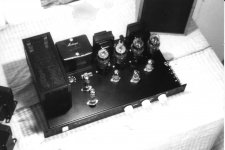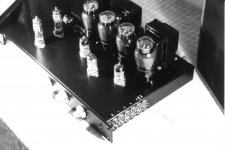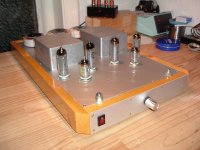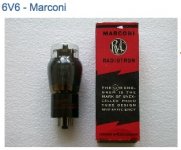If one were building an amp, Single Ended or Push-Pull, with 6V6 tubes or with EL84 tubes in the output position, what would the practical difference be? (Socket, of course!)
They are similar enough that I wonder what the practical implications would be.
What sort of things, from a practical standpoint, does one need to take into consideration if designing for one or the other? They seem similar enough that they could work in the same circuit, but I'd like to hear from some of you with experience in the matter what you would do differently with one or the other. Hi-Fi, not guitar amp.
Thanks
They are similar enough that I wonder what the practical implications would be.
- Same heater voltage, similar draw
- Can run on the same anode voltages
- Rg1 might be different
- Similar plate resistances, so similar or same OPT
- Similar max power
- Different transconductance
- Bias?
What sort of things, from a practical standpoint, does one need to take into consideration if designing for one or the other? They seem similar enough that they could work in the same circuit, but I'd like to hear from some of you with experience in the matter what you would do differently with one or the other. Hi-Fi, not guitar amp.
Thanks
Yeah, looking again I see the heater current is more different than I thought. The EL84 draws a good bit more. Not good if your heater circuit was designed with the 6V6 in mind.
More gain out of the EL84 could be an advantage. Any other differences worth mentioning? Or are these 2 tubes that will pretty much be used in similar circuits with similar results?
More gain out of the EL84 could be an advantage. Any other differences worth mentioning? Or are these 2 tubes that will pretty much be used in similar circuits with similar results?
One is a pentode, the other a beam tetrode. I'm puzzled that you keep asserting that they are pretty much the same. I would regard them as quite different: heater current, screen current, gain, bias all differ. They really only have two things in common: both intended for audio output, both have similar power ratings. The difference in gain is enough to possibly require a different driver circuit, as the 6V6 will need much more grid swing so a better driver to avoid driver distortion.
One is a pentode, the other a beam tetrode. I'm puzzled that you keep asserting that they are pretty much the same. I would regard them as quite different: heater current, screen current, gain, bias all differ. They really only have two things in common: both intended for audio output, both have similar power ratings. The difference in gain is enough to possibly require a different driver circuit, as the 6V6 will need much more grid swing so a better driver to avoid driver distortion.
EL34's, 6CA7's and KT77's are constructed totally different with the first being a pentode and the others beam tetrodes. Nontheless they are interchangable.
Agreed, the EL84 and 6V6 are less similar than these, but you can build an amp that can run on either type.
Some decades ago I build some guitar amps that have sockets for both. Sure, there is a difference in gain, so you turn the volume knob a bit.
For audio it should be similar, as long as you take the requirements of both types into account: the lower grid leak resistor of the 6V6 and the higher filament current of the EL84. Should you use NFB, then you could put a selector to change the NFB to serve both types.
Well if that's what I was asseting, it's not what I meant!One is a pentode, the other a beam tetrode. I'm puzzled that you keep asserting that they are pretty much the same.
For a couple of tubes that are not direct replacements, I see them used a lot in very similar circuits. What might be the advantages of either in a small power amp? In guitar amps they have different overdrive sounds, but we hope that won't be a factor in a Hi-Fi amp.
I seem to recall that the typical 6BQ5 has an edge in linearity over the 6V6, and have to admit that in similar circuits I have generally preferred the 6BQ5 over the 6V6. I will say a 6V6G is more visually appealing than the typical 6BQ5 though. My next small SE amplifier will be a 6BQ5 based design, having done what I think is a pretty mediocre sounding 6V6 design a few years ago. One thing I did notice is that the 6BQ5 seems to sound a lot better than 6V6 in triode connection IMVLE.. I guess I would choose the 6BQ5 unless I was after looks..
Both of them are great tubes. If I had to choose......hmm.... probably the 6V6 just because (from my limited experience) modern production 6V6's are more reliable. Socket is bigger, needs more space, not as easy to drive but not difficult either. The EL84 is a little bit more linear, with the right voltage and load of course.
6CA7 is supposed to be the same as EL34, even if implemented differently. KT77 was designed to slot into the same amplifiers. So all three are, by design, very similar in characteristics. Not comparable with the difference between 6V6 and EL84, which were never intended to be similar.Parafeed813 said:EL34's, 6CA7's and KT77's are constructed totally different with the first being a pentode and the others beam tetrodes. Nontheless they are interchangable.
The fact that people can swap 6V6 and EL84 in guitar amp circuits says nothing; people routinely swap 12AX7, 12AY7, 12AT7 and 12AU7 there too although all they have in common is a pinout and heater current.
6V6 and EL84 are almost bound to have a similar required anode load because they are designed to run similar power from a similar supply voltage.
EL84 may be more linear, but it has a reputation for short life probably because it just runs too hot. Also probably more likely to need a grid stopper due to high gm.
6V6 and EL84, which were never intended to be similar.
In fact, the small version of the 6V6 is the 6AQ5 as the RCA manual says, but has lower anode voltage ratings.
Hmm. Good points, thanks.EL84 may be more linear, but it has a reputation for short life probably because it just runs too hot. Also probably more likely to need a grid stopper due to high gm.
6BW6 tube is similar to 6V6GT (except base), sounding maybee bether than 6V6GT, but have shorter life at the same working condition!There is also the 6BW6, as I said, but that is not so well known outside the UK. I think it was a Brimar design, and is closer to the 6V6 than the 6AQ5/EL90 is.
6V6 is able to withstand much higher voltage ratings and abuse than EL84 - that is at least very important if you planing to use it in the triode mode.
My first real tube amp was triode-connected 6V6 PP ( with 330 V B+ and fixed bias with low current ) with tube rectifiers in mono-block configuration - to be honest maybe the very best and most musical sound I ever heard to date.
I also had EL84's in SE & PP and their sound is more on the clean side with stronger transients, while 6V6 renders more rounder tone similar to 6L6 tube. I love both of them...
Pictures of my first 6V6 PP tube amp from 1995 and EL84 PP from 2003...
Max
My first real tube amp was triode-connected 6V6 PP ( with 330 V B+ and fixed bias with low current ) with tube rectifiers in mono-block configuration - to be honest maybe the very best and most musical sound I ever heard to date.
I also had EL84's in SE & PP and their sound is more on the clean side with stronger transients, while 6V6 renders more rounder tone similar to 6L6 tube. I love both of them...
Pictures of my first 6V6 PP tube amp from 1995 and EL84 PP from 2003...
Max
Attachments
Nice nixie clock, tubemax!
I've done both 6V6GT and EL84 in triode mode SE, and from those two I'd lean a bit on the 6V6 side.
Though if run in triode mode, I would take a real triode 1626 any time. Sounds better, about the same output power and costs next to nothing NOS. Nice ST envelope to boot (for that theres's also of course the 6V6G like tubemax apparently has).
So my vote goes to 1626 if in triode. =)
I've done both 6V6GT and EL84 in triode mode SE, and from those two I'd lean a bit on the 6V6 side.
Though if run in triode mode, I would take a real triode 1626 any time. Sounds better, about the same output power and costs next to nothing NOS. Nice ST envelope to boot (for that theres's also of course the 6V6G like tubemax apparently has).
So my vote goes to 1626 if in triode. =)
Perhaps two points from me:
I like to break open old tubes and examine. The EL84 g1 is very close to a rather hotter cathode than for the 6V6/6AQ5. This can affect both consistency and long life.
Then I have experienced an occasional glowing g2 winding; the grids are not aligned as well as with a beam tube. This did not happen often, but is a point against any pentode. But the point is perhaps unimportant compared to the ease of driving an EL84. It can be driven very satisfactorily with a cathodyne phase splitter fed from a pentode - all in one tube; 6AN8, 6U8, what have you. For a simple high-quality power amplifier, that would be my preference.
I like to break open old tubes and examine. The EL84 g1 is very close to a rather hotter cathode than for the 6V6/6AQ5. This can affect both consistency and long life.
Then I have experienced an occasional glowing g2 winding; the grids are not aligned as well as with a beam tube. This did not happen often, but is a point against any pentode. But the point is perhaps unimportant compared to the ease of driving an EL84. It can be driven very satisfactorily with a cathodyne phase splitter fed from a pentode - all in one tube; 6AN8, 6U8, what have you. For a simple high-quality power amplifier, that would be my preference.
- Status
- This old topic is closed. If you want to reopen this topic, contact a moderator using the "Report Post" button.
- Home
- Amplifiers
- Tubes / Valves
- 6V6 vs EL84 for output



